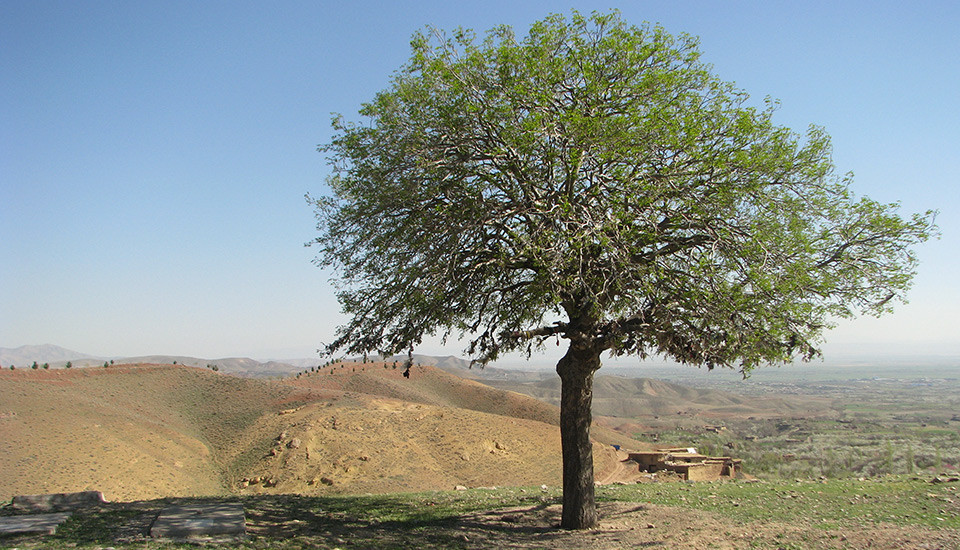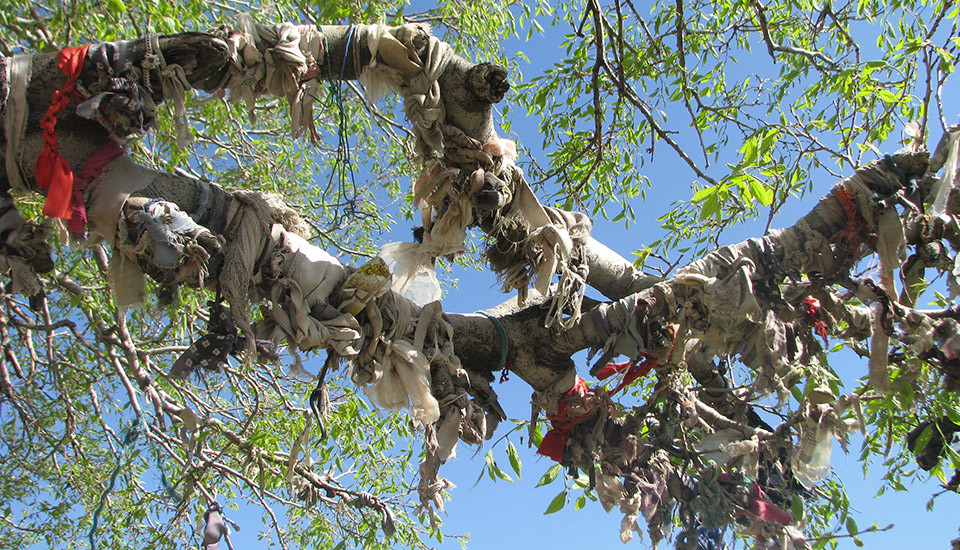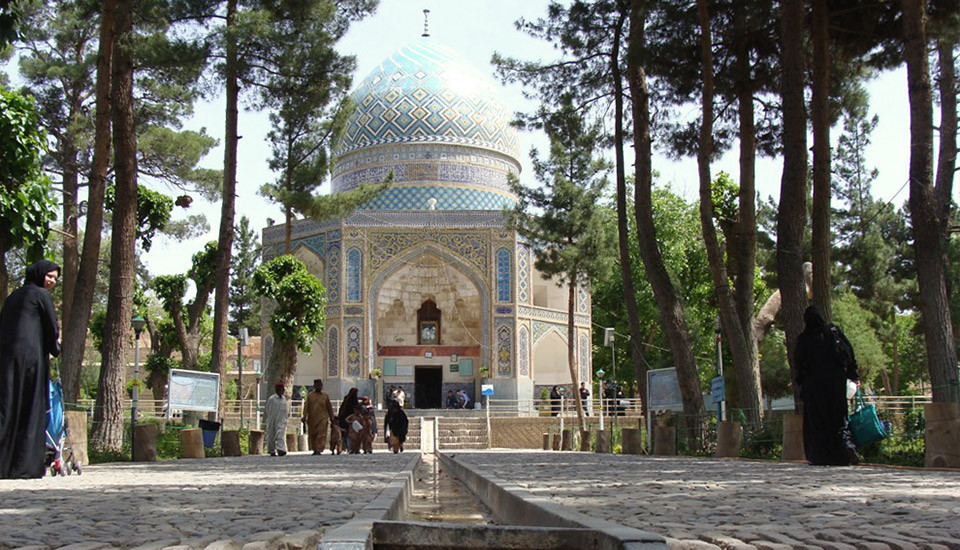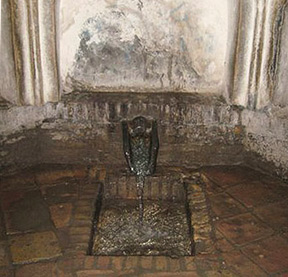Neyshabur er Township í North East Íran. Stór hluti af því er í miklum dalnum umkringdur hólum og fjöllum. Það eru mismunandi heilagt náttúruvætti í Township, allt frá heilagt tré og helgu lindir við heilaga klöpp og helga garðar. Svæðið hýsir nokkrar Einlend tegund plöntu og dýrategundum. It also contains protected areas and ecotourist destinations such as waterfalls, lindir, ám og auga smitandi landfræðileg lögun eins leiðtogafundum fjallið. The climate is semi arid to dry with an average annual rainfall of 300 mm.
In spite of the fact that these sites are protected by local communities, their future is threatened by urbanisation, population growth, infrastructure development and tourism.
Protected
Vörsluaðila
Local fólk virða náttúrulega eiginleika eins og þeir eru rætur sínar í trú þeirra. Qadamgah í Neyshabur til dæmis, er Persneska garð þar sem náttúran hefur verið imbued með andlegum gildum. Það inniheldur Mansion, tré, laugar og læki. Einn af veggjum húsinu inniheldur svartan stein sem tveir sporin hafa skapað. Fólk trúir þessum prent tilheyra 8. Imam Shiites, karlmaður andlegur leiðtogi talinn vera afkomandi Muhammed, guðlega tilnefnd að leiðbeina mönnum. Orðið Qadamgah þýðir fótspor og vísar til þessa frásögn.
Qadamgah’s history as a sacred site dates back to the pre-Islamic period. Though its original purpose is unknown, it is historically linked to the Sassanid prince Shahpour Kasra, as well as to Imam Ali and Imam Reza. Word goes that in 921 AD Imam Reza stopped at the garden on his way from Medina to Marv. The instant he wanted to perform his ablutions, a spring welled out of the earth. The spring has been regarded sacred ever since and people believe this water has healing properties.
Some plane trees (Plantanus sp.) have been actively conserved for centuries. Plane trees in Iran have been regarded as sacred for a long time because of the shade they offer, their largeness and their green appearance. All over Iran some plane trees have been kept alive for centuries. Legends and beliefs about some specimens have caused people to stay away from them. A long lived plane tree in a village of Neyshabur, til dæmis, is conserved by local people because they believe that a man once lost his family due to the breaking of its branches.
Local people still conserve lesser-known sacred sites which have no legal protection. Gildi slíkra staður er kennt að yngri kynslóða og trúarlegum og venjur eru gerðar communally, eins og þeir hafa verið um aldir. This vegur, næsta kynslóð lærir að vernda þá.
Þótt það sé formlegt stjórnun tækni, people tend to protect their sites. Some implement short term measures at a local level. Among a wide variety of plans that are carried out for example, a park has been established around a wish tree and tourist services have been developed there.
Aðgerð
Local people and religious institutions continue their age-old practices. The local offices of Cultural Heritage, Handicrafts and Tourism register long-lived trees as national natural monuments. National natural monuments are relatively small, interesting, unique, exceptional, unconventional and irreplaceable phenomena of plant and animal collections having scientific, historical or natural significance. Protective measures in these areas guarantee their sustainable non-commercial use.
There is also a national plan for inventory and conservation of long lived trees under supervision of the Skógar, Range and Watershed Management Organization of Iran. Recent research by Maryam Kabiri draws the attention to the significance of the spiritual values that these and other sacred sites have in relation to nature conservation.
Stefna og lög
Íran löggjöf hefur ekki minnast á heilagt náttúrusvæða svo langt. Sumir helgu náttúruminja hafa verið opinberlega varðveitt vegna þess að þeir eru staðsettir á verndarsvæðum eða í National Monument. Aðrir hafa verið sérstaklega skráð sem innlend Náttúruvætti. The Cultural Heritage og deild umhverfi yfirvaldsins hafa eitthvað að segja í verndun lands náttúrulega minnismerki. Þeir hvetja aðallega fyrir sjaldgæfa gróður og dýralíf eða merkilega myndunum lands, landslag eða jafnvel forn tré. Þau eru síðan flutt í trausti því að tilnefna viðeigandi jaðar.
Samtök
Some sacred sites in the area are under supervision of Endowments and Charity organizations (responsible for endowments and sacred places such as mosques and shrines) and a trustee board of local people. The Cultural Heritage, Handicrafts and Tourism Organization is responsible for registration and management of historical monuments and national natural monuments.
Qadamgah, til dæmis, has been registered in this way, but it is also under supervision of endowments and charity organization of Iran and of the local trustee board. As in the case of Qadamgah, when a site has both cultural and spiritual values these organisations cooperate in the conservation and management of the site.
Conservation verkfæri
Criteria for conservation have been set up and these criteria have led to maps of areas in the township of Neyshabur which are in need of prioritized conservation. Some recommendations have additionally been formulated in this thesis, which may help with the initial steps for planning political agenda and developing criteria and indices of a national natural monument such that takes spiritual values into account.
Niðurstöður
Sacred natural sites as a part of bio cultural diversity have been protected for centuries by local beliefs and values. Nowadays these sites are threatened for different reasons. If they are to survive, núverandi ráðstafanir þurfa að vera studd af réttarvernd. Í þessu skyni, taka upp stefnu sem byggist á sameiginlegum viðmiðunum og stefnu á sviði náttúru og menningu geta gegnt lykilhlutverki í verndun helgu náttúrusvæða. Kabiri Hendi (2011) skilgreind svo skilyrði um verndun helgu náttúrusvæða í Township í Neyshabur.
- Bahar, M. (1995) From myth to history. Cheshmeh Publication, Tehran, Íran.
- Daneshdoost, J. (1992) Persian Garden. Asar Journal, Vol.12: 48-52.
- Kabiri Hendi, M. (2011) The land evaluation for conservation of natural sites with spiritual values, a case study of Neyshabur Township. MSC thesis at Tehran University, Karaj, Íran.
- Taheri, A. (2009) Neyshabur Tourism Guide. Abarshahr, Mashhad, Íran.
- Pakdaman, B (2005) Qadamgah Garden Complex, Amagazine, issue7:86-93.







